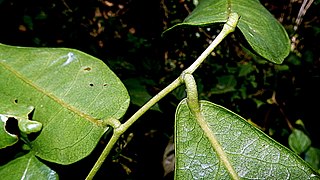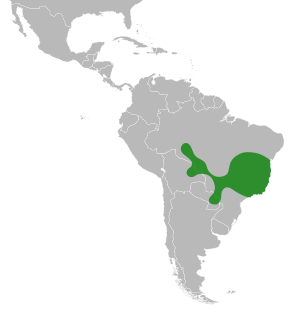
Cyamopsis is a genus of the family Fabaceae. Its species are distributed across Africa, Asia and the Pacific.
Alexa is a genus of flowering plants. Members of this genus accumulate iminosugars in their leaves.

Geoffroea is a rather small genus of wild spiny shrubs or small trees of tropical and subtropical South America. Although it gathers few species, they are highly extended geographically throughout the subcontinent. Each species is well known in its local area, as seen from the varied usage of these trees as food, timber, or fuel. It was recently assigned to the informal monophyletic Pterocarpus clade within the Dalbergieae.
Angylocalyx is a genus of flowering plants in the family Fabaceae. It contains the following species:

Chapmannia is a genus of flowering plants in the family Fabaceae, and was recently assigned to the informal monophyletic Pterocarpus clade of the Dalbergieae.

Poecilanthe is a genus of flowering plants in the family Fabaceae.

Leptolobium is a small Neotropical genus of plants in the family Fabaceae, with ten species currently recognized. With the exception of Leptolobium panamense, which occurs in tropical forests from northwestern South America to Mexico, all species of Leptolobium are restricted to South America and most diverse in Brazil. Most Leptolobium species have been traditionally included in AcosmiumSchott (Fabaceae), but both genera have been recently distinguished based on several vegetative and reproductive traits.
Guianodendron praeclarum is a South American legume endemic to the Guiana Shield. It is the only member of the genus Guianodendron. It has been segregated from Acosmium based on its unique combination of vegetative and floral traits, and it is related to Diplotropis.It is the only member of the genus Guianodendron.

Amicia is a genus of flowering plants in the legume family, Fabaceae, and was recently assigned to the informal monophyletic Adesmia clade. It belongs to the subfamily Faboideae. It is named in honor of the Italian astronomer, mathematician and microscopist Giovanni Battista Amici (1786–1863).

Bowdichia is a genus of flowering plants in the legume family, Fabaceae. It belongs to the subfamily Faboideae.

Brya is a genus of flowering plants in the legume family, Fabaceae. It belongs to the subfamily Faboideae, and was recently assigned to the informal monophyletic Pterocarpus clade of the Dalbergieae. Species include Brya ebenus, a valuable timber tree.
Bryaspis is a small genus of flowering plants in the legume family, Fabaceae. It belongs to the subfamily Faboideae, and was recently assigned to the informal monophyletic Dalbergia clade of the Dalbergieae.
Cascaronia astragalina is a species of flowering plant in the legume family, Fabaceae. It belongs to the subfamily Faboideae, and was recently assigned to the informal monophyletic Pterocarpus clade of the Dalbergieae. It is the only member of the genus Cascaronia.

Cranocarpus is a genus of flowering plants in the legume family, Fabaceae. It belongs to the subfamily Faboideae, and was recently assigned to the informal monophyletic Pterocarpus clade of the Dalbergieae.
Cyclocarpa stellaris is a species of flowering plant in the legume family, Fabaceae. It belongs to the subfamily Faboideae, and was recently assigned to the informal monophyletic Dalbergia clade of the Dalbergieae. It is the only member of the genus Cyclocarpa.

Cyclolobium brasiliense is a species of flowering plants in the legume family, Fabaceae. It belongs to the subfamily Faboideae. It is native to Bolivia, Brazil, and Paraguay and is the only member of the genus Cyclolobium.

Lamprolobium is a genus of flowering plants in the legume family, Fabaceae. It belongs to the subfamily Faboideae.
Myrospermum frutescens, the cercipo, is a species of flowering plant in the legume family, Fabaceae. It belongs to the subfamily Faboideae. It is the only member of the genus Myrospermum.
Nissolia, the yellowhoods, is a genus of lianas in the legume family, Fabaceae. It belongs to the subfamily Faboideae, and was recently assigned to the informal monophyletic Adesmia clade of the Dalbergieae.

Smithia is a genus of flowering plants in the legume family, Fabaceae. It belongs to the subfamily Faboideae, and was recently assigned to the informal monophyletic Dalbergia clade of the Dalbergieae.












